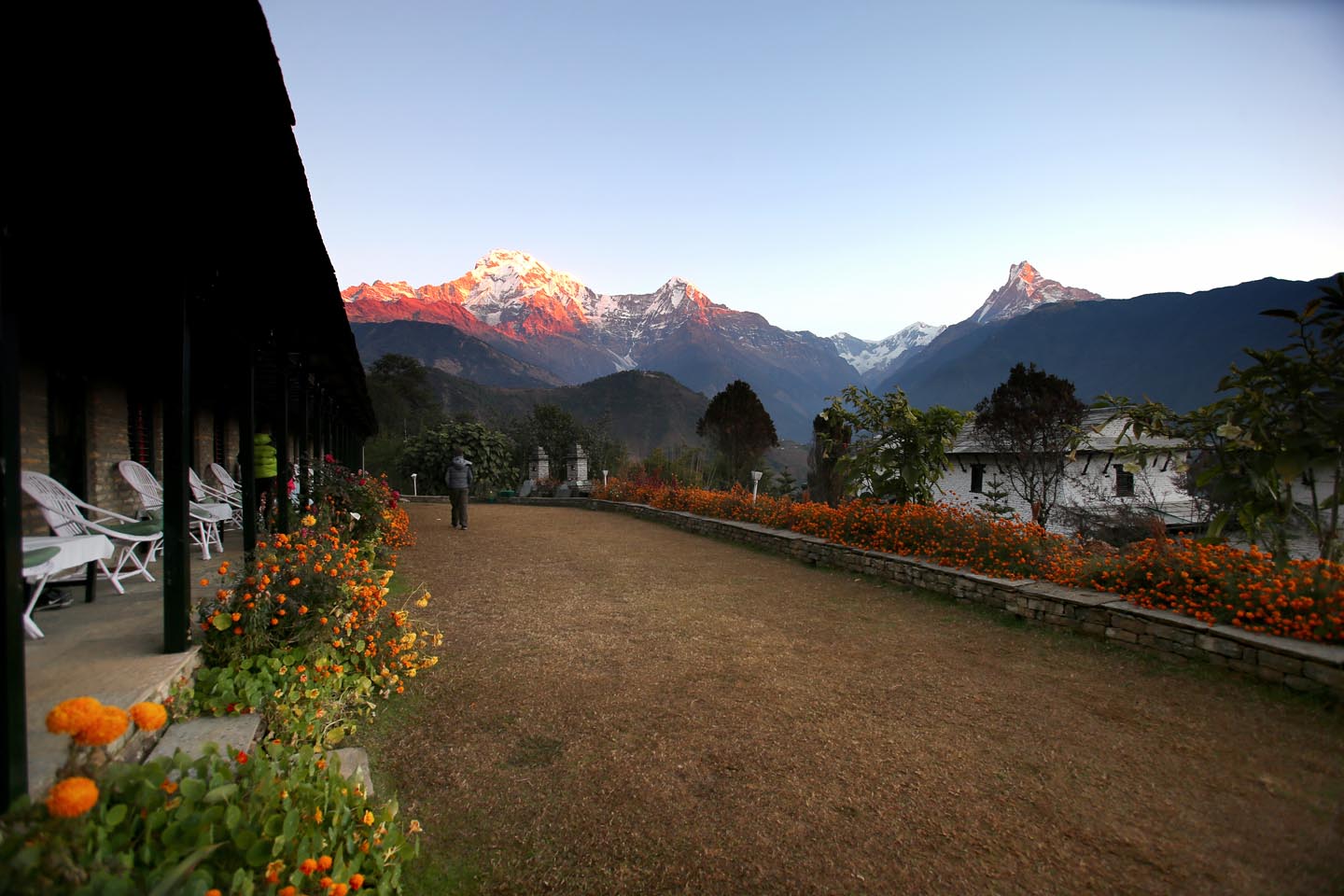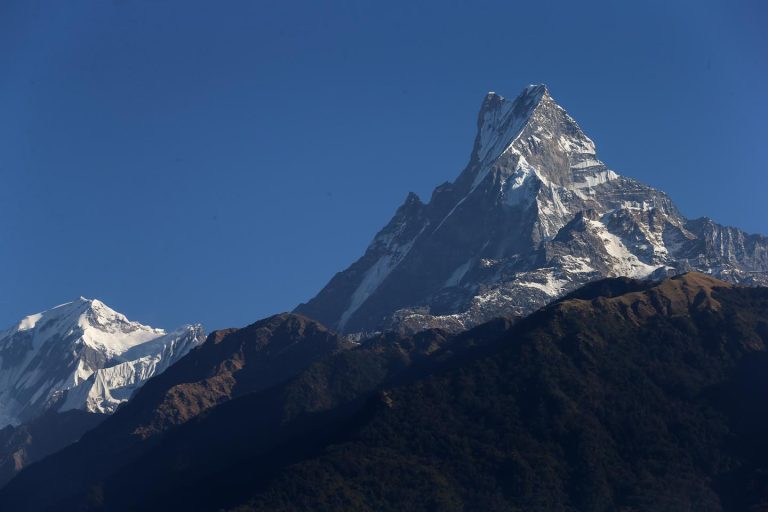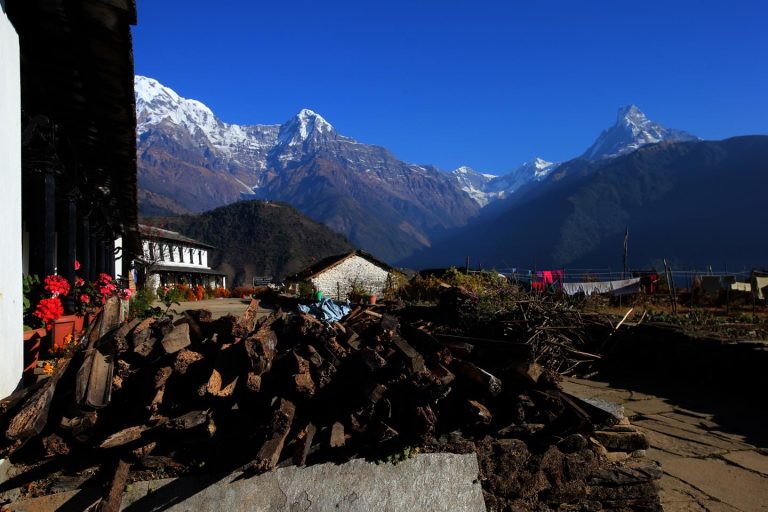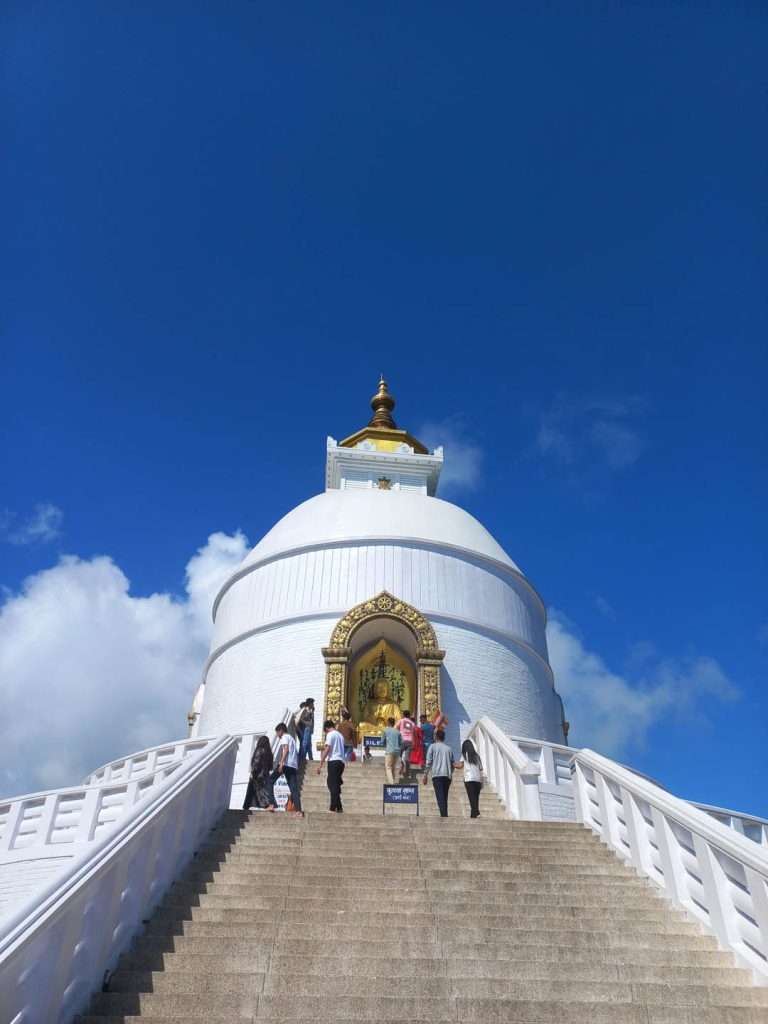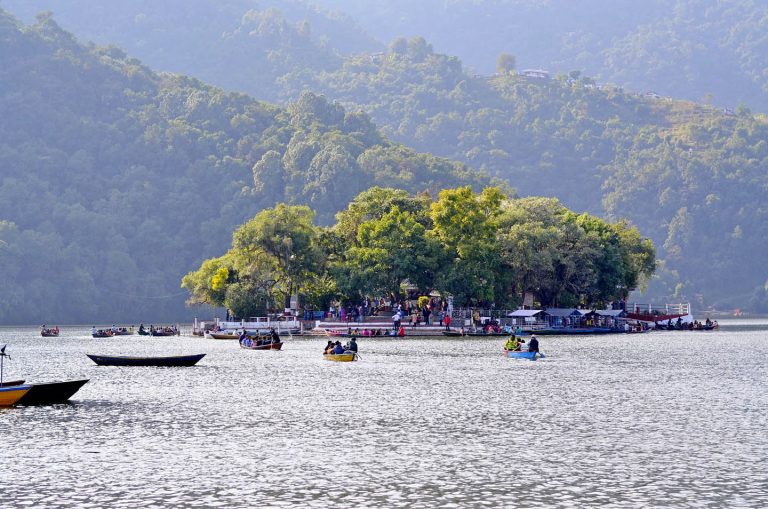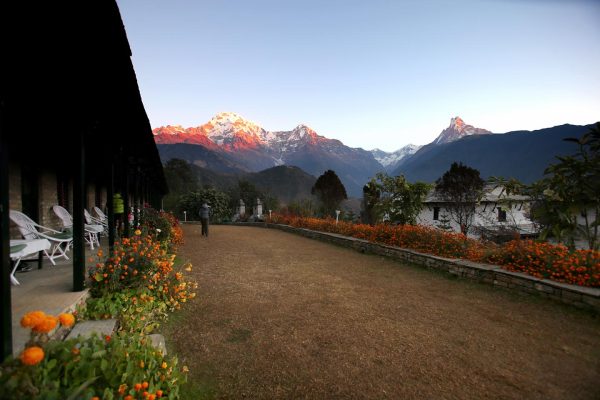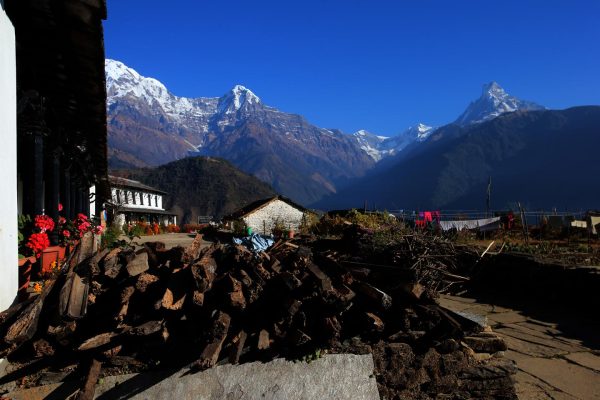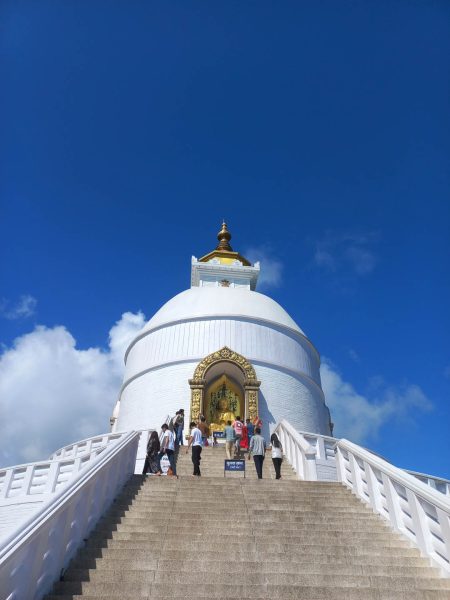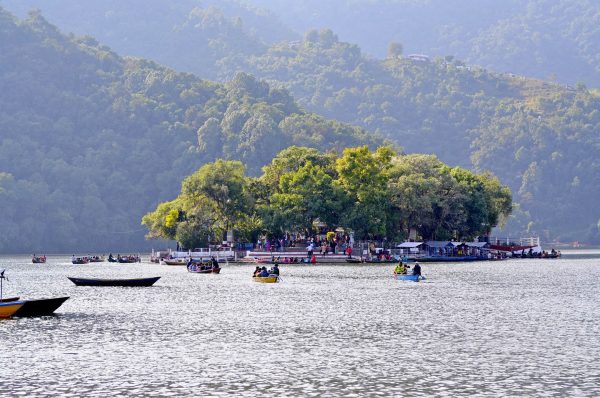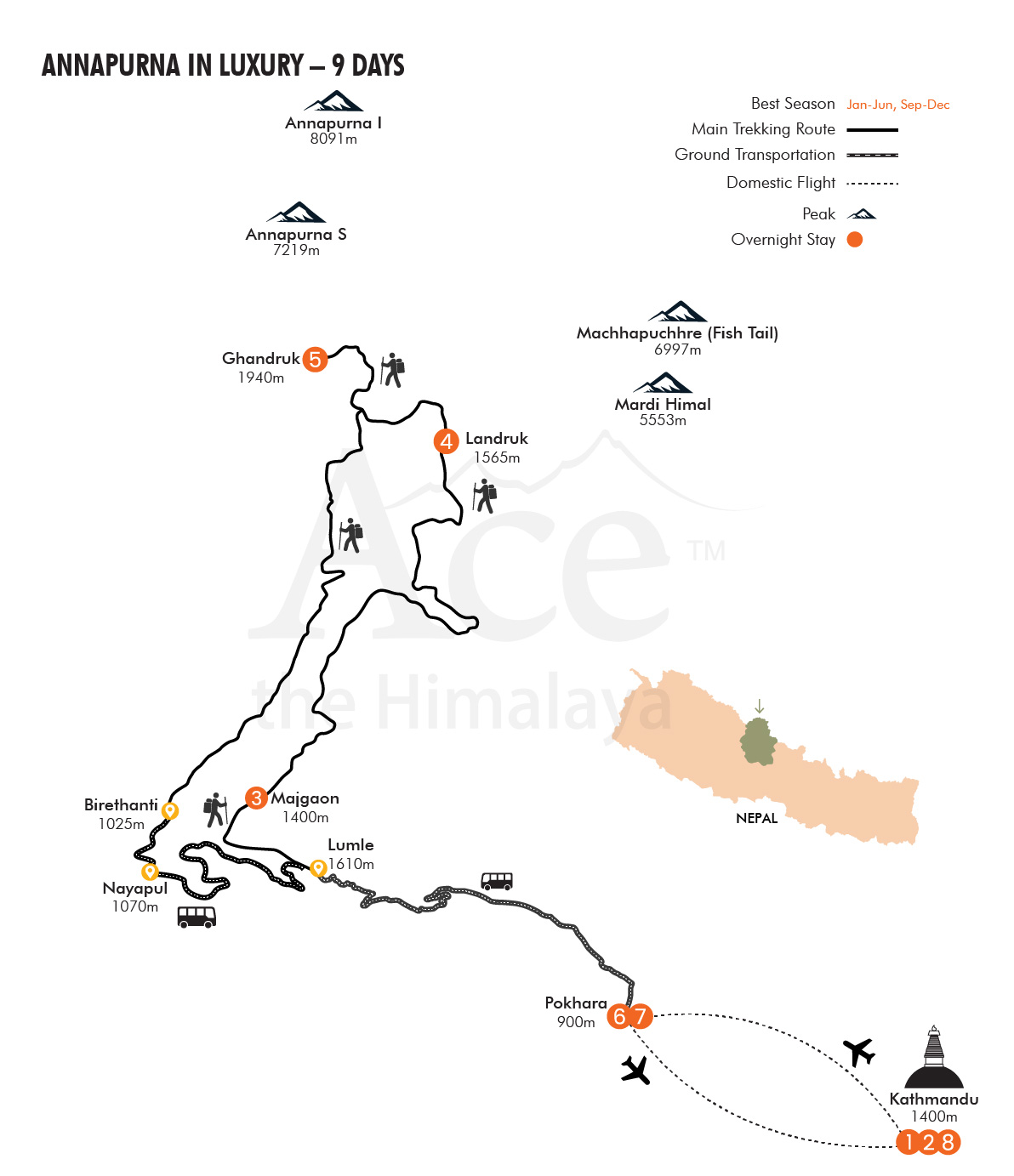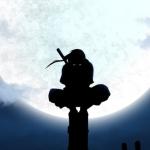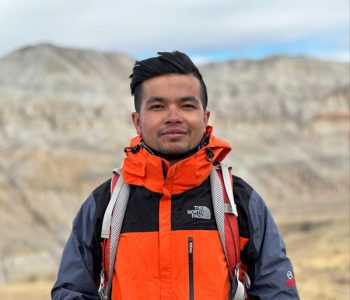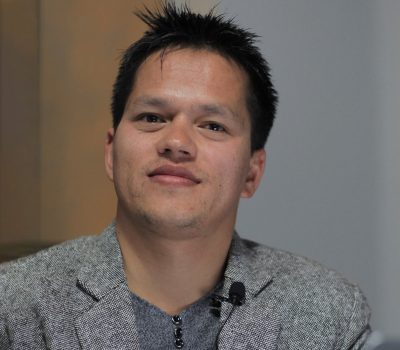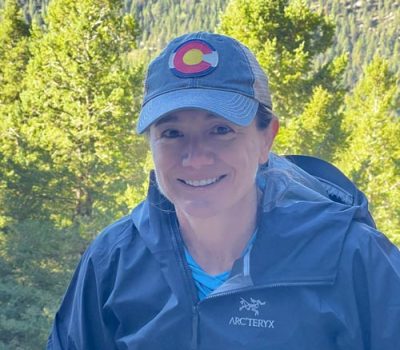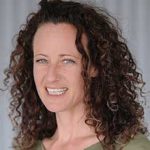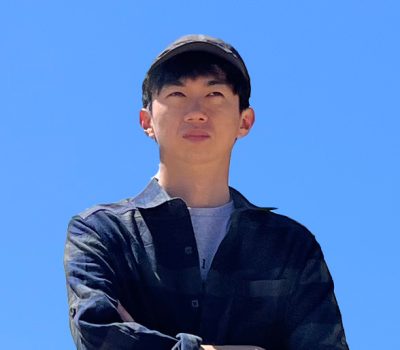Annapurna in Luxury - 9 Days
Be a part of the beautiful Himalayas, explore the typical Nepali villages of Annapurna Region in comfort and style with our trek Annapurna in Luxury.
Trip Highlights
- Sightseeing in the World Heritage Sites: Bhaktapur Durbar Square, Pashupatinath Temple and Boudhanath Stupa.
- Scenic flight to Pokhara.
- Sightseeing and exploration at Pokhara.
- Explore Gurung culture in Ghandruk village.
- Walking through colorful rhododendron forests.
- Magnificent views of the mighty Annapurnas.
- Explore the beautiful city of lakes, Pokhara.
- Stay at the finest accommodation.
Trip Overview
Traveling through Annapurna in luxury is the finest decision for anyone willing to travel through the beautiful Himalayas in comfort. This moderately difficult walk does not demand any stress at any point.
This trek offers the most opulent and lavish accommodations in five-star hotels in Kathmandu and Pokhara. Likewise, it also offers the most comfortable and luxurious guesthouses in the trekking regions as well. Unlike other trips, this Annapurna luxury trek takes our customers’ convenience and comfort into account.
The second day is spent touring the famed cities of Patan and Kathmandu in the Kathmandu Valley. An excellent way to begin is with a visit to the UNESCO World Heritage Sites. The third day, of the trip, takes you to Pokhara, where the hike officially starts.
The treks through the rhododendron forests, oak and maple trees, and the Himalayas, which surround you on all sides, are truly exciting. Likewise, guesthouses along the trails will be really comfortable and offer all the possible amenities.
Thus, the variation in landscapes, flora, fauna, culture, and ethnic communities is easily noticeable and extremely beautiful. The Himalayan ranges from Ghandruk and Landruk, as well as the villages, terraced farms, and lush rhododendron forests, are all absolutely stunning.
For trekkers who want the comfort that hotels and guesthouses can provide along with the chance to hike to the highlands of the Annapurna Region, the Annapurna in Luxury trip is a dream come true.
Short Itinerary
Arrival at Kathmandu (1,400 m) and transfer to hotel. Overnight at Hyatt Hotel or a similar class hotel in Kathmandu.
Whole day sightseeing in Kathmandu valley. Overnight at Hyatt Hotel or a similar class hotel in Kathmandu.
Fly to Pokhara (900 m) – 35 minutes flight in the morning. Trek to Majgaon (1,400 m) – 1 to 2 hours. Overnight at Gurung/Mala Lodge or a similar class Guesthouse.
Trek to Landruk (1,565 m) – 4 to 5 hours. Overnight at La Bee Lodge or a similar class Guesthouse.
Trek to Ghandruk (1,940 m) – 4 to 5 hours. Overnight at Himalaya Lodge or a similar class Guesthouse.
Trek to Birethanti (1,025 m) – 4 to 5 hours. Drive back to Pokhara – 1 to 2 hour. Overnight at Shangri La Village Resort or a similar class hotel.
Full day guided sightseeing in Pokhara. Overnight at Shangri La Village Resort (Pokhara) or a similar class hotel.
Morning Flight to Kathmandu. Overnight at Hyatt Hotel or a similar class hotel in Kathmandu.
Transfer to the International Airport for Your Final Departure.
 Note
Note
Our standard itinerary might differ slightly due to unpredictable happenings and events out of our control. Factors such as flight cancellation/delay, unfavorable weather, natural calamities, newly implemented government rules, political affairs, trekkers’ health conditions, etc., are possible. Evaluating the situation’s possible solutions allow the trekking to resume as much as possible based on the best alternatives. In these times, we look for your cooperation and flexibility.
It is advised you arrive one day before the trip start date so you can rest, and it also gives you time to buy clothing, equipment, and gear required for the trek. Also, it is best if you book your flights with spare days in Nepal for this trek in case of any flight delays or cancellations. Moreover, you have options to customize this trip where you can add on a sightseeing tour in Kathmandu, Pokhara, other adventure sports, or day trips around the country before or after the trek.
Departures & Availability
Looking for personalized experience? We organize privately guided journey which is mainly designed to fit your taste and interest. Please fill out the form below to get started.
Price Includes
Accommodation
- Twin-sharing/double accommodation in a 5-star hotel in Kathmandu for 3 nights and Pokhara for 2 nights including breakfast (Private room accommodation can be organized at an extra cost)
- Luxurious Twin-sharing guesthouse accommodation during the trek in the Annapurna region for 3 nights
Meals & Drinking Water
- All your standard meals during the trek (Breakfast, Lunch, and Dinner) including seasonal fruits
- A farewell dinner on the last night in Nepal
- Filtered, Purified or Boiled water in the trails.
Transportation
- All (international and domestic) airport transfers on a tourist vehicle
- Round trip airfare between Kathmandu and Pokhara including airport departure tax in Kathmandu and Pokhara airport.
Activities
- Guided city tour in Kathmandu and Pokhara by private tourist vehicle
Guide and Staff
- Experienced, first-aid trained, government licensed, English speaking, and locally recruited Ace the Himalaya’s trekking guide (2 guides for group size more than 7 people)
- Porters during the trek for carrying luggage (1 porter for every 2 clients)
- Wages, accommodation, meals, gear, insurance, and medications for all staff
Permits & Entry fees
- Sightseeing/Monument entrance fees in Kathmandu
- Annapurna Conservation Area Permit
- TIMS (Trekkers’ Information Management System) card
Benefits and Takeaways
- 1 Ace the Himalaya’s duffel/kit bag, trekking map, sun hat, Buff (Neck Gaiter)
- Trip completion certificate
Administrative
- All administrative expenses and government taxes
Price Excludes
- Meals (lunch and dinner) in Kathmandu and Pokhara
- International flight fare and airport departure tax
- Alcoholic beverages, cold drinks and juices.
- Travel insurance along with high-altitude emergency evacuation coverage
- Tips to trekking staff and driver
- Nepal Entry Visa (Visa can be acquired easily after your arrival at Tribhuvan International Airport in Kathmandu with a fee of USD 30 for 15 days visa, USD 50 for 30 days visa and USD 125 for 90 days visa)
- Personal Trekking gear and equipment
- Any expenses other than the Price Include section
Detailed Itinerary
Expand AllDay 01: Arrival at the Tribhuvan International Airport in Kathmandu and transfer to hotel
Our airport representative will be receiving you at Tribhuvan International airport, Kathmandu. S/he will be displaying an “Ace the Himalaya” signboard outside the airport terminal. You will then be received and transferred to your respective hotel in our private tourist vehicle.
Note: If you happen to arrive after 4 pm you would be briefed about the trip by our guide, this will be the pre-trip meeting for you, so please make sure that you ask all the questions. But if you arrive earlier than 4 pm, your pre-trip meeting would be on that very day at our office.
During the meeting, we will introduce your trek leader/guide. For the meeting, please make sure you bring your passport, three copies of passport-size photos, and a readable copy of your travel insurance policy. During this meeting, please clear the due balance, if any, and sign the legally binding trip form as well as the non-liability disclaimer.
Day 02: Guided sightseeing around Kathmandu Valley.
After a hearty breakfast, at 8.30 am your sightseeing trip will start. You will have a private vehicle and a professional tour guide at your disposal. Today we will visit some heritages listed below:
Pashupatinath Temple:
Pashupatinath Temple is one of the most significant Hindu temples of Lord Shiva in the world, located on the banks of the Bagmati River. Though you are not allowed to go inside the temple as it is strictly for Hindus only, you can clearly see the temple and the activities from the eastern bank of the Bagmati River. It is a square two-tiered pagoda temple built on a single-tier plinth which is famous all over the world.
Boudhanath Stupa:
Boudhananath is one of the holiest Buddhist sites in Kathmandu. It was built in the 5th century with four pairs of eyes of Lord Buddha in four cardinal directions keeping an eternal watch over the people and their doings. You will find Buddhist pilgrims from Tibet going round the stupa spinning the prayer wheels.
Bhaktapur Durbar Square:
Visit the Bhaktapur Durbar Square, the Royal Residential Quarter of Bhupatindra Malla, famous five-storied temple of Nyatapola in Pagoda style Batsala temple, Bhairavnath temple, Duttatraya temple, Pujari Muth and Palace of 55 windows.
The rest of our time in Kathmandu is free for further exploration and some last-minute shopping in Thamel area for trekking essentials.
Day 03: Morning flight to Pokhara & Trek to Majgaon
The morning flight of 35 minutes takes you to the beautiful city of lakes and the second most popular tourist destination of Nepal, Pokhara. The flight offers magnificent views of the Himalayan ranges and the snow-capped peaks.
Upon reaching Pokhara, you will be taken to Lumle, the starting point of the trek. The drive will be for an hour and you will be taken in a private vehicle. After walking for around 45 minutes, we reach the beautiful Chandrakot village. You can take a glance and enjoy the beauty of the Himalayan ranges, the Fishtail, and the Annapurna South and rest for a few minutes.
The walk further continues towards the Gurung village called Majgaon. Only walking for another 45 minutes we reach the luxurious Guesthouse where we’ll be staying.
The rest of the time in this village can be spent either relaxing and resting or exploring.
Day 04: Trek to Landruk
After the morning breakfast, we bid farewell to the beautiful village and head back to the trail.
Today’s trail takes us through the lustrous and green rhododendron forests, the small Gurung villages that arrive every few hours, and the giant Himalayan ranges that accompany us time and again. After walking for 4 to 5 hours we reach the beautiful village of Landruk.
We have our lunch, rest for a few hours, and begin the exploration of the villages.
Day 05: Trek to Ghandruk
The morning breakfast prepares us to head back on the trail to reach Ghandruk village, one of the most popular villages on the Annapurna trail. The trail descends towards Modi Khola and then ascends steeply to reach Ghandruk.
Upon reaching Ghandruk and after lunch, you can explore the beautiful village of one of the ethnic groups of Nepal. They have their own dialect, culture, costume, and lifestyle.
Ghandruk is also home to many Gurkha soldiers. It is a famous trekking destination as it is known for its beautiful mountain views of mountains like Annapurna South, Gangapurna, Annapurna III, Hiunchuli, and Machhapuchhre. We can also visit Annapurna Conservation Office, Gurung museums and explore the village.
Day 06: Trek to Birethanti and drive back to Pokhara
We bid farewell to the beautiful place and descend down towards Birethanti. The walk will be for 4 hours. Along with bidding farewell to the village, we also do the same to the giant mountains.
Upon the descent towards Birethanti, the mountains seem farther away. We stop for lunch at Birethanti and rest for some time. We drive back to Pokhara which takes around 1 hour and transfer back into the hotel.
Day 07: Full day guided sightseeing in Pokhara.
After breakfast, a full day sightseeing tour of Pokhara city begins. There will be a professional city guide and a private tourist vehicle at your disposal. You will visit the following sites:
Bindhabasini Temple:
The temple lies in the center of the religious old bazaar. It is dedicated to Goddess Bhagwati, another manifestation of Shakti. The park grounds offer a fine picnic and relaxing area.
Davis fall:
Locally known as Patale Chhango and located in the southern flank of the Pokhara valley, it is where the stream flowing from Fewa Lake collapses and surges down the rock into a deep gorge, leaping through several potholes. This is hugely popular with tourists and locals alike.
Gupteshwor Cave:
The revered Gupteshwor Cave is situated 2 km from the Pokhara airport. The entrance is right across from Davis fall and the cave is almost 3 km long. It has some big hall-sized rooms and some passages where you have to crawl on all four. This cave holds special value to Hindus since a phallic symbol of Lord Shiva is preserved here in the condition it was discovered.
Seti River Gorges:
Carved by the Seti Gandaki River, it is one of the natural wonders of Pokhara. K.I. Singh bridge at Bagar, Mahendrapool and Prithivi Highway Bridge near bus park provide a perfect view of the river’s dreadful rush and the deep gorge made by the turbulent flow of white water.
Tibetan Refugee Camps:
The Tibetan camp Tashi Ling, which is behind Gupteshwor Cave, is renowned for the production and trade of woolen carpets and other handicrafts. The original Tibetan settlers in this region migrated to Nepal in the ‘50s.
World Peace Pagoda:
World Peace Pagoda, also known as Pokhara Shanti Stupa, is a Buddhist pagoda-style monument. It is the shrine built as a symbol of peace. The spot is situated at the height of 2,100 meters on the Ananda Hill. Nepal has two of the eighty peace pagodas in the world i.e. Shanti Stupa in Lumbini, the birthplace of Buddha, and Shanti Stupa in Pokhara. It also provides a panoramic view of the Annapurna range, Pokhara city and Fewa Lake.
Day 08: Morning Flight to Kathmandu.
After early morning breakfast, the 30 minutes flight from Pokhara brings us back to Kathmandu. The rest of the day can be spent strolling around Thamel, buying gifts and souvenirs or grabbing a nice preferred lunch.
In the evening we will have a farewell dinner in a traditional Nepalese restaurant with cultural performances.
Day 09: Transfer to the International Airport for your Final Departure
The trip concludes – our airport representative will drop you at the international airport in Kathmandu for your flight departure from Nepal.
Gears and Equipment
Here is a list of what you might want to pack for the hike. Please take this as a starting point. You’ll need layers of warmer clothing during the winter. We provide a 75-liter duffel bag for you to use for the trek. It will be given to you during your pre-trip meeting in Kathmandu. The duffle bag is yours to keep.
General
- Puffy down jacket (We have rental jackets available for an additional USD 35)
- Daypack (35-45 liters recommended) with rain cover
Upper Body
- Sun hat or cap (We'll provide you with a free Ace the Himalaya baseball cap.)
- Knitted hat/Beanie
- Scarf or neck gaiter
- Headlamp
- Sunglasses
Torso
- Technical fabric base layer (light for warmer months, heavy for colder months)
- Technical fabric short (2) and long sleeve (2) shirts
- Waterproof, windproof shell
- Fleece jacket or pullover
Lower Body
- Technical fabric base layer (light for warmer months, heavy for colder months)
- Hiking pants (2)
- Comfortable pants for inside the teahouses
- Waterproof/windproof outer shell pants
- Hiking shorts
Hands
- Wool or technical fabric liner gloves
- Hard-shell outer gloves (insulated for colder months)
Feet
- Wool or technical fabric warm socks
- Hiking socks
- Liner socks (optional such as silk)
- Trekking/hiking boots (waterproof recommended)
- Ice Cleats /Micro Spikes (For trekking from November to March, it's recommended to include Ice Cleats/ Micro Spikes to prevent slipping on icy or wet surfaces.)
- Casual shoes
Undergarments
Note: The quantity of each article of clothing can be adjusted to suit the preferences of each participant.
- Technical fabric/quick drying is best for underwear (opportunities to launder during the trip)
- Sports bras (women)
- Pajamas or sleeping clothes
First Aid Kits and Medications
- (Note: Guides carry medications and first aid kits during the trip. However, personal kits and medications are highly recommended.)
- Sunscreen
- Lip balm
- ointment
Other Essentials
- Passport
- Extra copies of passport-sized photos
- Reusable water bottle
- Toiletry kits
- Water purification tablets or UV water purifier (if you plan to treat water)
- Hydration bladder
- Towel
- Pillowcase
- Toilet paper (2 rolls)
- High protein snacks (such as protein bars or nuts)
- Waterproof/dry bags for carrying important documents and money
- Airline tickets (Please leave a copy at our office in Kathmandu. This can be useful if there is a change in the date of the flight.)
- Earplugs
- Trekking poles
Optional
Once in Nepal, if you have the time, you can purchase supplies and gear for hiking. Thamel, Kathmandu’s tourist hub, is home to many shops where you can get a variety of reasonably priced trekking equipment.
- Power bank or extra batteries
- Cameras and mobile phone
- Cards/book
- Pee bottle/ pee funnel for women
- Whistle
- Thermos for hot water
Important Information
- We give you a free duffel bag and baseball cap during your pre-trip meeting in Kathmandu. The duffel bag will be used to pack your trekking supplies.
- For every two participants, we assign one porter. The duffel bag, which should weigh around 10 kg/22 lbs, will be carried by the porter throughout the walk.
- To carry your daily necessities like cash, crucial papers, a water bottle or bladder, a camera, toiletries, sunscreen, a notebook, clothing, etc., you must have your own daypack (with a waterproof cover).
- You can store your luggage (non-trekking items) at the hotel in Kathmandu.
- Down jacket with a hood is a must for altitudes above 4,000 m to keep warm. We provide both a down jacket and a sleeping bag, which must be returned after the trek. In case of loss or damage to these items, the reimbursement cost is USD 200 per item.
Note: Some clothing, especially form-fitting, figure-hugging items made of elastic material (like yoga pants), may offend locals. Therefore, if you choose to wear these clothes for comfort, please make sure to wear something over them.
Trip Video
FAQs for Annapurna in Luxury
General
Why trek with Ace the Himalaya?
Ace has a reputation for successfully leading treks with knowledgeable leaders and staff taking care of all your travel needs. We are a certified sustainable travel company that also endorses the idea of giving back to the community by participating in various philanthropic activities. Here are 17 reasons why you should choose Ace the Himalaya for your next adventure!
Is Nepal open to travelers following the Covid-19 pandemic?
Indeed, Nepal is entirely open. Travelers are welcome in Nepal without any restrictions. Arriving travelers can obtain a visa on arrival at the Kathmandu airport as well.
What are the conditions to travel to Nepal post Covid-19?
Traveling to Nepal is now hassle-free. You don’t need a vaccination certificate or negative PCR test, but check with your airlines and transit countries for any specific requirements.
We suggest you look at the Nepal immigration site https://www.immigration.gov.np for the most up-to-date information.
What additional documents do I need?
- Two passport-sized photos (2×2 inch) to give to our office staff
- A copy of your international flight ticket to give to our office staff
- A copy of travel insurance to give to our office staff
Do we book our own international flights to and from Nepal?
Yes, you need to book your own international flights. We are a local agent and it would cost you significantly higher to book through us. Please find more information in the International Flight page.
Is hiring a guide necessary even if I have trekking experience?
You can hike without a guide. A guide is there to assist you in going forward and making alternative plans and arrangements when unanticipated occurrences happen or when things get difficult. Our hiking leaders are qualified experts. When talking about their trip, our guests frequently remark on how much fun they had and how crucial their guide was to make it successful.
Can the guide speak English?
Yes, our guides can speak English. Most of them start their careers as porters and work for 3 to 4 years before becoming trekking guides. Their English skills are based on real-world experience rather than formal education. While they are able to communicate effectively, please note that English is not their first language, so their fluency may not be on par with native speakers. They will also assist with communication, especially since many locals, like shopkeepers and teahouse hosts, may not speak English.
Weather and Temperature
What is the best season for this trek?
Our trekking season extends from mid-September to May. From early September, the monsoonal rains decrease. By end of September to December, the weather is usually stable with mild to warm days, cold nights. February, March, April, May, June, October, November, December is the best time to do this trek.
What kind of weather and temperature can I expect while trekking?
One of the most unpredictable elements of the mountain is the weather. If you’re not properly prepared for the twists, turns and volatility of the conditions that can occur in this breathtaking region, you might find yourself in an uncomfortable and unpleasant situation. Here are some weather basics to help ensure that you come to the Himalayas as well equipped and prepared to face anything.
Generally speaking, the nights are much cooler than the daytime hours in the Annapurna region. Many first-time trekkers are surprised to learn about the incredible range that may occur in a given day. During the day, the thermometer could reach temps as high as 25 degrees C (77 Degrees F), only to dip down as low as -5 degrees C (23 Degrees F) in less than 24 hours. While there’s no way to know exactly what each day in the mountains will bring, the weather and temperature ranges tend to be somewhat predictable based on the month and season.
Spring – March / April / May / June
Spring happens to be one of the best times of the year to visit the Annapurna region. That is why it can become somewhat crowded. The beautiful clear blue sky can be seen and the many different species of flowers are visible at the lower altitude.
During springtime, the average temperature is 25 degrees C (77 Degrees F), with a maximum of 30 degrees C (86 Degrees F), during sunny days and a minimum of 10 degrees C (50 Degrees F), in the morning and at night for areas above 1500 meters.
July / August Through Mid-September is Monsoon Season
This season is not really recommended to travel as it rains in the lower altitudes. However, there are positive sides of trekking during the monsoon months. The excess rainfall can provide ample chance to see spectacular views of the waterfall and it’s also the best season to avoid the crowds.
During this time, the average temperature is 25 degrees C (77 Degrees F), with a maximum of 30 degrees C (86 Degrees F), during sunny days and a minimum of 15 degrees C (59 Degrees F), in the morning and at night for areas above 1500 meters.
Autumn – End of September / October / November
Similar to springtime, autumn in this region is also a crowded season. But it’s one of the best times to trek. While it lacks the beauty of flowers, the clear blue sky can be seen, affording incredible views from just about every angle.
The average temperature during the fall is 20 degrees C (68 Degrees F), with a maximum temp of 25 degrees C (77 Degrees F), during sunny days and a minimum of 5 degrees C (41 Degrees F), in the morning and at night, for areas above 1500 meters altitude.
Winter- December/ January/ February
Winter starts from mid-December till mid-February in this region. People still like to trek this month due to fewer crowds.
The average temperature during the winter is 10 degrees C (50 Degrees F), with a maximum temp of 17 degrees C (62.6 Degrees F), during sunny days and a minimum of -5 degrees C (23 Degrees F), in the morning and night, for areas above 2500 meters altitude.
The temperature mentioned above is based on the outdoor temperature of the guesthouse temperature. No need to worry about the cold temperature as we provide the sleeping bag plus an additional blanket to make sure our clients are warm enough during the time of need.
What is the temperature rating of the sleeping bag that you lend to trekkers?
The temperature rating of the sleeping bags that we rent to trekkers is about -10°C (14°F). Also, our guides can obtain extra blankets if needed at the teahouses.
Arrival and Visas
Is it possible to obtain a visa for Nepal upon arrival at the airport?
Yes, you can obtain a Nepal visa upon your arrival at the airport. There are kiosks in the arrival hall that you use to complete the necessary forms. The cost is USD 30 for a 15-day tourist visa, including numerous entries, or USD 50 and USD 125 for a 30-day or 90-day tourist visa including numerous entries respectively. You should carry cash (USD) with you to pay your visa fees quickly and easily, as digital payments are frequently unavailable.
To save time, we recommend filling out the online visa application form in advance. Applying online 2 weeks before your arrival will expedite the process at the airport. For detailed guidelines, please refer to our blog titled Guidelines for Online Tourist Visa Form in Nepal.
Who will come to pick me up at the airport upon my arrival?
Our staff will be waiting for you outside the airport terminal with our signboard (Ace the Himalaya). You will be accompanied to a hotel in a private tourist vehicle.
Payments and Extra Costs
How much additional money do I need per day?
Typically, around USD 15 per person per day will be sufficient. This is for purchasing snacks and covering lunch or dinner expenses in Kathmandu and Pokhara. If you wish to buy souvenirs or native Nepali goods, it’s advisable to bring extra cash with you.
Is it possible to use credit cards in the places I visit during the trek?
In Kathmandu and Pokhara, yes – to some extent. Once you are out of the cities, all you need is cash. Please change the currency in local Nepali Rupees before you go to the mountains.
Is it possible to reserve a trip now and pay a deposit later, or do I have to pay a deposit at booking/reservation?
When you book, you must pay a 30% deposit to secure your itinerary. The remaining balance can be paid upon your arrival at Kathmandu or before arrival. US Dollars cash and credit cards (Visa, Master, and American Express) are accepted once in Nepal. Please note a 4% transaction fee will be added for all credit card transactions.
How do I pay the remainder of my balance upon arrival in Kathmandu? US Dollars cash or credit card?
You can make payments via US Dollars cash or credit card (Visa, Master, and American Express). A 4% transaction fee is added if paying with a credit card. Thus, we encourage you to pay with USD cash if you are planning to pay upon your arrival in Kathmandu.
We prefer you pay with larger bills (USD 50 or 100). Please note that the cash should not be older than 2009 and in good condition, as banks do not accept worn, torn, or crumpled bills.
Who Can Trek?
Do I need prior trekking experience?
Previous trekking experience is not required if you are physically healthy and have enough enthusiasm for the trek.
Are there any age requirements for mountain trekking?
Our treks have no age restrictions if members are healthy and willing. We have had families with kids as young as 5 years do the treks along this region, and our oldest adventurers have been in their late 70s.
Is trekking to mountain regions safe for solo female travelers?
It is safe for a female to trek alone in Nepal. Nepal is usually regarded as a safe nation for female visitors traveling alone. It is entirely safe for a solo woman to trek with Ace the Himalaya on any of our treks.
Physical Fitness
What kind of physical training is necessary for trek preparation?
For trekking, you must prepare your body to walk over uneven, hilly landscapes while carrying a backpack. Walking at an incline, jogging, cycling, and going for long-distance hikes are all good ways to exercise. You should work out for at least one hour four to five times a week for at least two months before trekking.
What are the physical standards that I need for the trek?
Participants in good physical condition should be able to complete this trek. If you are not physically active, we advise starting an exercise regimen two months before the trek that includes at least an hour of walking at an incline, running, or biking four to five times a week.
Incorporating hiking into your workouts is ideal. It is advised to speak with a doctor before making travel arrangements if you have any health conditions that could affect your ability to complete the trek.
Trek Preparation and Packing
What are the procedures after I make my deposit?
After making the deposit, one of our staff will email you for further information. We will require a copy of your passport photo page and your arrival/departure flight details. We will also provide you with additional trip information.
What sort of insurance do I need? How can I obtain a policy?
Travel insurance is mandatory for our hiking itineraries. We require your policy have medical evacuation coverage for the maximum elevation of your itinerary. Insurance may also cover additional costs in the event of a flight delay or cancellation caused by bad weather, medical costs, theft, loss, and damage to your items while traveling.
Travel insurance can be obtained online by one of several travel insurance companies. Please note that insurance obtained from an airline at the time of booking your flight may not cover medical evacuation coverage.
What are the necessary items that I should pack for my trip?
You can find the necessary items to pack for the trek here on the Equipment section. Gear and equipment can be bought or rented upon your arrival in Kathmandu. If you plan on buying or renting gear in Kathmandu, please allow extra time.
Do you provide sleeping bags or down jackets for rent?
Yes, we do provide sleeping bags or down jackets for rental costs of USD 35 each. Do let us know before initiating the trek and we shall provide items. You can view the photos of the gear at this link: Photos of the Gear.
What type of bag will the porters carry?
We provide you with a free duffel bag of 70 to 80-liter capacity that our porters will carry. The maximum weight that porters can safely carry is 30kg, and each porter is assigned to two people.
However, each porter carries a maximum of 25 kg/55 lbs in total during the trek period. Your duffel bag, which should weigh no more than 12.5 kg/27.56 lbs per client, will be carried by the porter throughout the trek.
What type of daypack should I bring?
We suggest a 30 to 40-liter capacity daypack. Wider straps and hip belts are recommended to assist you in carrying weight evenly and reduce pain.
What about my passport, medications, and belongings?
Bring copies of your passport, insurance papers, and other essential items in your carry-on during your flight. If you need to take medications daily, keep them in your daypack with your other essential possessions. You can store other non-trekking essentials in the office of Ace the Himalaya or at the hotel in Kathmandu.
Will there be a place to store items/clothing not required for the trek?
The hotel in Kathmandu and Pokhara does provide the free storage services. So, you can leave all your items that are not required for the trekking at your hotel.
Do you use porters on the trek or do we carry all of our own gear?
Whilst on the trek, our porter will take care of your luggage. All you need to carry is your small day bag for your personal belongings like camera, water bottle, sun cream etc.
Accommodation
What kind of lodging is available in Kathmandu, Pokhara and on the trek?
We use twin or double bedrooms at five-star hotels in Kathmandu, Pokhara with breakfast included. The hotels provide the rooms according to the preference.
During the trek, your stay will be at the guesthouses and lodges that are best known for the comfort and luxury they provide. The guesthouses provide you with either king-sized beds or twin beds accommodation.
The accommodation will thus be comfortable and convenient throughout your trip. For further information see Teahouses in Annapurna region.
Are the guesthouses heated?
The guesthouse does not facilitate with heater or air conditioner. However, as it gets colder above 3,500m, they do have facility of hitting the dining area by providing kerosene or metal heater. USD 1 to USD 3 per person would be applicable to use this service and this is payable directly to the guesthouse.
What are the Toilet facilities in the tea house/guesthouse?
Most of the tea houses do have western style flushing toilet however in higher elevation you could find the squat toilets made of either a ceramic basin on the ground or few planks precariously positioned over a hole in the ground which is always outside of the room.
Is it necessary to bring toilet paper for the trek?
All the guesthouses sell the toilet paper, so you can buy it there itself. As for hand sanitizer, towel and any other personal toiletries you need for the trek, you must bring your own.
Where do we go to toilet along the trail?
There are toilet facilities in the teahouses/lodges during the trek. Trekkers can also find private areas along the trail for emergencies.
What sort of food can I expect in trekking?
Multiple food choices are available in the guesthouses. Options include daal bhat (rice and lentil), bread, eggs, potatoes, noodles, soup, pasta, and pastries. We suggest eating vegetarian during the trip. You will find a great deal of garlic on the menu since it helps with acclimatization. Each meal includes one hot drink. Hot drinks include coffee, hot chocolate, tea, and hot lemon drinks. You can purchase an additional hot drink or sometimes soda at your own expense. You can also purchase candy or cookies (crisps) at your own expense.
I'm a vegetarian. Is that a problem?
Most of the teahouses in the mountains offer vegetarian meals. So, being a vegetarian is not a problem. Vegetarian meals are preferable to avoid food poisoning and indigestion.
Is the food in the mountains prepared to international standards in terms of safety?
Indeed, the guesthouses follow international guidelines while setting up the food and serve you clean, protected, and warm meals.
What is the drinking water facility in the mountain?
Bottled water is easily available at the lodges and teahouses, which you can buy at the cost of USD 1 at lower elevations to USD 4 to higher elevation per liter.
If you are planning to drink normal water all the way during trek, purifying water with any sort of purification tablets or drop is must. You can bring your own purifier or can purchase it in Kathmandu.
On the other hand, water filling stations are pretty common in the Annapurna region. On the trails, they have been designated at various locations where it is safe to consume the water.
Can we get hot or boiled drinking water? Does it cost extra?
Yes, teahouses do provide hot boiled water for an extra charge of USD 2 to 5 per liter. The cost varies and increases at higher altitudes.
Can I shower/bathe during the trek?
Most of the guesthouses provide proper running (both hot and cold water) shower and attached toilet facility.
What happens if I end up staying an extra night/s in Kathmandu due to an unforeseen delay or cancelation?
In case of unforeseen circumstances such as flight cancellation, your health, or for any reason you decide to discontinue the trip and arrive early in Kathmandu then you will need extra accommodations in Kathmandu. The cost of the teahouses in the mountains is not equivalent to the cost of a hotel in Kathmandu. In such cases, we will arrange your accommodations, but you will need to pay a supplemental charge.
Can I charge my electronic equipment during the trek?
Yes, you can charge your equipment during the trek for an additional cost. The cost will vary but is around USD 1-5 per charge. Two pins (type C) and three pins (type D) adaptors are highly recommended. Bring these adaptors or purchase them while you are in Kathmandu.
Health and Safety
Do your guides have the trekking guide certificates from the Hotel Management and Tourism Center? Have they received first aid training for high altitudes?
We provide licensed trekking guides with fluent English. Our guides are certified by the Hotel Management and Tourism Center after receiving 45 days of training. Similarly, the guides receive high-altitude training from Kathmandu Environmental Education Project (KEEP).
What are safety measures in place? What safety equipment do your guides carry on the trek to deal with sickness/accidents?
Our guides are well trained and certified in first aid. Throughout the journey, our guides will evaluate your condition and your oxygen level using an oximeter. Our head office receives continuous updates on your condition and location through the guides. In places without a phone signal, your situation will be updated through a satellite phone during emergencies.
How do you allocate guides and porters in a group?
We allocate one guide for groups of up to 8 participants. For groups of over 8 participants, we allot an associate guide. As per the size of the group, we may add more guides or divide them into sub-groups.
We provide one porter for every two clients. Two clients’ duffel bags will be carried by one porter. The weight limit is 25 kg (55 lbs) or 12.5 kg (27.56 lbs) for each client. For an additional cost, we can arrange for one porter to carry one participant’s duffel.
Is Ace the Himalaya's staff insured?
Our company insures all our trekking staff members, including guides, cooks, Sherpa, and porters. Please browse through our legal docment page to view insurance details.
What vaccinations will I need?
While no vaccinations are strictly mandatory for travel to Nepal, it is highly advisable to take precautionary measures to protect your health. To ensure a safe and enjoyable trip, we recommend the following vaccinations: Routine Vaccines, Malaria, Japanese Encephalitis, Hepatitis A, Hepatitis B, Typhoid, Rabies, Cholera, etc.
It is also helpful if you inform us of any medical condition that is relevant so we may convey this information in the event of an emergency. Ace the Himalaya keeps your medical condition confidential unless treatment is necessary.
What if I am very sick in the mountain?
Our guides are 24 hours available for the services during the trek. They are trained to use first aid kit and have knowledge to use Oxy meter. They are very much aware that higher the altitude the oxygen level gets lesser so to get updated on the oxygen level of our client and to know whether they are fit enough or needs extra precautions to continue.
Guides carry local sim cards both Nepal Telecom and Ncell in order to update whereabouts and situation of our every client. During the time of emergency our guides are alert and keeps updated to head office in Kathmandu that is available 24 /7 to arranging from horse to mules or helicopters in the must needed cases especially when client is seriously sick in the mountain and needed to be hospitalized.
What is necessary for sun protection during the trek?
Even when the sun isn’t shining, sun protection is essential. UV rays are reflected by the snow and the harshness of the sun will damage your skin before you notice it at high elevations. Therefore, proper clothing and sunblock are necessary. Hat, sunscreen, sunglasses, clothes, etc. are vital for sun protection.
What kind of trekking boot would be best for the trek?
An important piece of equipment is your trekking boots. Invest in a durable and comfortable pair, preferably with water-proof lining. Boots that provide ankle support on rough ground and have stiff soles are recommended.
Do you guys have a PAC (Portable Altitude Chamber)?
Yes, we have access to a portable altitude chamber in case of an emergency. It is not essential to carry during the trek. Though, we can use arrange it upon request for an extra cost of USD 200.
Practical Matters
What is your cancellation policy?
Notice should be provided 20 days before the trip start date in case of cancellation. The trip can be canceled for justifiable reasons. Once the trip is canceled, a fee of 30% of the trip cost is retained for administrative costs.
However, the trip amount is entirely non-refundable if the cancellation is not made before the 20 days as per our terms and conditions. For submitting a claim to your insurance company after the cancellation, we can assist with documentation such as a receipt of monies paid. Refund will not be provided for unused accommodation in case of trip cancellation caused by personal reasons/sickness/weather.
More information about our cancellation policy can be found here in Terms and Conditions page.
Do I need to tip my guide and porter? How much would that be?
Tipping is both expected and appreciated, and it reflects your satisfaction and enjoyment of the trek. We recommend tipping based on the number of participants in your trekking group and the duration of the trek. As a general guideline, consider allocating at least 10% of your total trek cost for tipping. Detailed tipping recommendations for your guides and porters will be provided during our pre-trip briefing in Kathmandu.
Is there any communication while we are trekking?
Yes. The guides carry local cell phones, so you can use their cell phones if necessary and reimburse them. Assuming you have brought your cell phone, you can obtain a local SIM card and use it. Our guides or representatives can help you get a local SIM card after your arrival. There is the availability of Wi-Fi at most teahouses for an additional cost. We utilize satellite telephones for emergencies.
Does it cost an extra amount if I am a solo traveler?
If you are a solo traveler and book one of our published dates, there is no additional fee. If you sign up for a private trip or change the trip date from one of our published trip dates, you will be charged an additional fee.
Is there a provision for a refund policy if I don't accomplish the trek?
Trekkers occasionally fail to complete the journey for medical or personal reasons. In this situation, be aware that we do not issue any refunds for products purchased or unused trek days. We must pay our administration staffs, guides, and porters, purchase trekking permits, and all other booked accommodations in advance, so our expenses remain the same.
Who else will be joining my trekking group?
Our Annapurna in Luxury is primarily a private trek. Occasionally, there may be open spots available for those interested in joining a group. If you wish to participate in a group trek, please feel free to contact us. However, the trek is generally conducted as a private experience.
Can I add extra days to my trekking trip?
You can extend your trekking trip for an additional cost. Potential arrangements will be made if we get a request from your guide. This is applicable for private or solo trips as the itinerary can be easily adjusted. The addition of extra days is bound by time when you are in a group. Therefore, discuss with your group and guide, what changes can possibly be made.
I want to extend my holiday, any recommendations?
Yes, you can extend your holiday. Ace the Himalaya offers many options and alternatives for your holiday extension. For more information, you can visit our Day trips pages.
Transportation and Flights
Do I need to book my international flights for the travel to Nepal?
Yes, you must book your international flights. We are a local agency and do not make international flight arrangements. You can easily browse through flight tickets in airlines sites to book ones most feasible for you.
Are all your departure guaranteed to run?
YES, all our trips are guaranteed to run. We never cancel the trip due to not having enough participants; we can arrange the trip for one person as well as a private trip at a very minimum additional cost. Please inquire about this during the time of booking.
What form of transportation do you utilize?
We provide you only those options, which enhance your local experience while allowing you to travel comfortably and efficiently. We use private tourist vehicles for sightseeing, city tours, and pickups. Depending on the group size we use cars, minibusses, vans, and tourist buses to and from Kathmandu/ Pokhara. All the vehicles are usually air-conditioned unless you are traveling in cooler areas.
For flights from Kathmandu-Pokhara-Kathmandu, we use Budhha air, Yeti air, Simrik air, and Summit air; all the popular airlines for domestic flights in Nepal.
Traveler Reviews
These full and frank reviews are from travelers who have traveled with Ace the Himalaya previously. The reviews and experiences shown here are from reputable travel websites like TripAdvisor & Google.
 Google Reviews
Google Reviews
What makes this trip different ?
Our CSI with Sambhav Nepal
- Ace the Himalaya believes in giving back to the communities that surround and support tourism in Nepal. Ace provides logistical support and, if needed, cash donations to the projects of Sambhav Nepal (a local NGO).
- Sambhav Nepal and Ace work together to plan volunteer programs that will bring in foreign volunteers and make use of their enthusiasm, time, and talents in a variety of projects.
Sustainability and Responsible Tourism
- Of the few Travelife Certified companies in Nepal, Ace the Himalaya is one. We respect the procedures for sustainable tourism. Our excursions are socially and environmentally conscious, leaving the lowest possible impact in the Himalayas.
- About 80% of Ace the Himalaya’s staff members are natives of the regions where our trips are organized. It is one of our sustainable and responsible efforts to help local communities, support small businesses, and promote regional culture and way of life.
